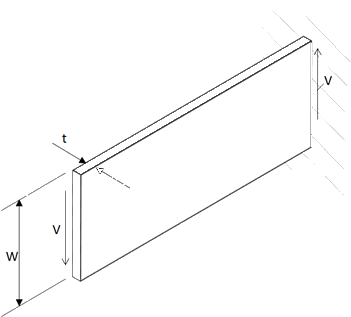Fundamental to structures analysis are the ideas of load, flow and stress.
- Load is a
measure of force, a moment (which is regarded as a type of applied load) is a
measure of twisting or bending force.
- lb (Load)
- inlb (Moment)
- Flow is a measure of load or moment per
length or width
- lb/in (Load Flow)
- inlb/in (Moment Flow)
- Stress is a measure of load per area – or
stress can be thought of as flow per thickness.
- lb/in2
The assessment of the effect of loads and moments on a structure, the derivation of relevant flows and stresses, and comparing these with appropriate failure criteria is the process of structures analysis.
The difference between load flow and stress is a useful distinction when interpreting hand analysis and finite element model results.
Using a cantilever shear beam as an example:

Consider a shear beam loaded with ‘V’. The beam has a width (or depth) of ‘W’ and a thickness of ‘t’.
Note that this example is statically determinate. i.e. the load transfer through the structure is not affected by stiffness.
The reaction load, V is not changed by either W or t .
The Shear Load Flow V/W is affected by the width of the beam but not the thickness.
And finally, the average shear stress:

is affected by both the width and the thickness.
Conversely:
- The reaction load is unaffected by changes in both the width and the thickness
- The Flow is unaffected by the thickness
This is particularly important when the engineer is dealing with a finite element model using plate elements. If the engineer uses plate elements (and the model is ‘reasonably’ statically determinate) the model need not be re-run to consider webs of different thicknesses if load flow results are used from the model – because the load flow is unaffected by the thickness.